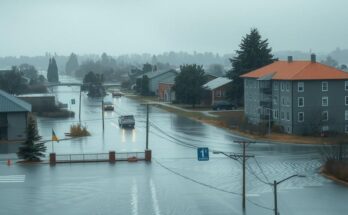Recent shallow earthquakes near Fentale volcano in Ethiopia have raised alarms about a potential eruption. The highest recorded tremor was M5.1 on December 29. Experts warn that magma intrusion could be the cause of these quakes, which have been felt across a broad area, including Addis Ababa. Local communities are advised to stay alert as the region experiences heightened seismic activity.
A series of shallow earthquakes have been recorded in recent days surrounding the Fentale volcano in Ethiopia’s Main Ethiopian Rift, heightening fears of an imminent eruption. The most significant event occurred on December 29, registering a magnitude of 5.1 and originating approximately 46 kilometers north of Metahara. Experts are concerned that increased seismic activity, indicative of potential magma movement, could lead to volcanic eruptions, echoing the last eruption of the volcano in 1820.
Over the past two days, numerous tremors varying between magnitudes 4.3 to 5.1 have been observed, with the latest quake of magnitude 4.7 reported at 07:42 UTC on December 30. Dr. Tom Pfeiffer from VolcanoDiscovery emphasized the potential for magma intrusion to breach the surface. “The risk of a new volcanic eruption in this part of the African Rift is now higher than before,” he stated, urging caution among local populations.
The earthquakes, occurring at shallow depths of 10 kilometers, have been reported widely felt in the region, including in Addis Ababa. With no local seismic network to accurately gauge this uptick in seismic activity, it is likely that many minor quakes have gone undetected. Residents of towns such as Metahara and Awash, with populations of 23,400 and 11,400 respectively, have reported experiencing tremors throughout the night.
Historically, the Fentale volcano has been characterized by significant volcanic activity, having last erupted in 1820, producing basaltic lava flows. The volcano lies at the northern end of the Main Ethiopian Rift, an area known for its frequent seismicity and volcanic phenomena due to the divergence of the Nubia and Somalia tectonic plates. Experts are advising local communities to remain vigilant as geological surveys indicate ongoing activity beneath the volcano, which may result in an eruption.
The wider East African Rift System spans over 3,000 kilometers and is considered the most prominent continental rift, hosting multiple active volcanoes. Past seismic events, such as the 1989 earthquake swarm in the Afar Triple Junction, show the region’s susceptibility to seismic incidents. The geological landscape of the Fentale volcano includes a caldera formed by historical eruptions, creating a complex interplay of volcanic activity and tectonic movements.
Due to the alarming seismic events and the potential for an eruption, authorities have issued advisories for local residents to be prepared for possible evacuations. The complexity of monitoring this phenomenon is exacerbated by the absence of local seismic networks, underscoring the necessity for preparedness in the event of elevated volcanic activity.
The Fentale volcano is situated in the tectonically active Main Ethiopian Rift, a region defined by the divergent movement of tectonic plates. This geological setting is conducive to frequent seismic and volcanic activity, making it crucial for residents to be aware of potential threats, notably from magma movement beneath the surface. The Fentale’s historical eruptions, such as the last in 1820, emphasize the necessity for vigilance given the recent uptick in seismic activity. Furthermore, the volcanic landscape and tectonic dynamics contribute to the region’s complex geological behavior, leading to frequent earthquakes and a significant risk of eruptions.
In summary, the recent surge in seismic activity near the Fentale volcano poses a significant risk of eruption, necessitating heightened awareness and preparedness among local populations. Historical precedence, coupled with scientific observations, suggests that magma intrusion could lead to an eruption if the activity intensifies. Authorities are taking steps to monitor the situation closely, although challenges remain due to the lack of local seismic networks.
Original Source: watchers.news




